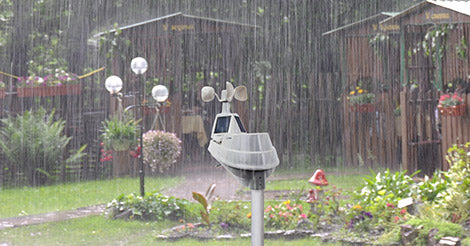Weather Sensor Maintenance
Keep your AcuRite Weather Sensor operating at its best by following these steps in the Spring and Fall.

Spring Cleaning Tips
Don't forget your weather station when you are doing your Spring cleaning! Whether you have the AcuRite Optimus, AcuRite Atlas or AcuRite Iris weather station, the below steps, tips, and tricks will help you measure your true backyard weather conditions, as seen on your indoor display, AcuRite NOW or My AcuRite app.
Step 1 - Check Rain Bucket to Ensure Proper Rainfall Measurement
Is your rain gauge reporting 0 inches of rain when it has been raining all day? If so, your rain gauge may be clogged, preventing the internal tipping cups from doing their job and recording rainfall.
If you have an AcuRite Atlas, follow these steps to clean your rain gauge sensor:
- Remove the batteries from your AcuRite Atlas outdoor sensor and detach the black rain bucket from the bottom half of the sensor.
- Remove any insects, cobwebs, or debris in the sensor and rain bucket using an old toothbrush for hard-to-reach places.
- Use a damp cloth to clean off the internal tipping cups and drip pan.
- Place a small amount of car wax on a soft cloth and wipe the tipping cups to help ensure rainwater flows through smoothly.
- Reattach the rain bucket to the bottom of the AcuRite Atlas outdoor sensor and reinstall the batteries.
Pro Tip! — To defend against insects crawling into your AcuRite Atlas, use tape to place a mothball in the nook near the tipping cups. For additional information, visit this AcuRite Atlas No Rainfall support page.
If you have an AcuRite Iris (5-in-1), follow these steps to clean your rain gauge sensor:
- Open your AcuRite Iris outdoor sensor by removing the four outside screws from the bottom of the unit (note: the near-the-center screws are only for rain gauge calibration).
- Remove any insects, cobwebs, or debris in the sensor using an old toothbrush for hard-to-reach places.
- Use a damp cloth to clean off the internal tipping cups.
- Place a small amount of car wax on a soft cloth and wipe the tipping cups to help ensure rainwater flows through smoothly.
- Reassemble your AcuRite Iris by replacing the four screws.
Pro Tip! — To defend against insects crawling into your AcuRite Iris, use tape to place a mothball in the nook near the tipping cups. For additional information, visit this AcuRite Iris No Rainfall support page.
Important to Remember!
Removing the batteries from your weather station (or the rain gauge if you have the stand-alone unit) eliminates the chance of sending any erroneous rainfall measurements to your AcuRite NOW or My AcuRite app. and in-home display.
Step 2 - Check Wind Cups and Anemometer to Ensure Accurate Wind Information
To receive hyperlocal wind information, it’s imperative to make sure your cup anemometer and wind vane are able to spin freely. Clear out any visible dirt, dust, or debris with a damp rag or paper towel. In colder climates, freezing rain or ice can freeze these instruments and restrain them from spinning, so be sure to check after any early spring storms!
If any parts are cracked, broken, or not spinning freely after cleaning, you can order new wind cups for the AcuRite Atlas, AcuRite Iris, and AcuRite Notos®. You can also order a replacement wind vane for the AcuRite Atlas and AcuRite Iris directly from AcuRite. If ordering new parts, check out the lightning sensor or wind extension to add a new feature to your weather station!
Pro Tip! — After cleaning, make sure your outdoor sensor is mounted at least 5 feet in the air without any surrounding obstructions for the most accurate wind speed and wind direction measurements. While the National Weather Service recommends mounting wind measurement instruments 33 feet or higher without obstructions within 100 feet, we recognize that not everyone has the means to do so. However, know that your AcuRite weather station will provide an accurate reading for the location your sensor is mounted.
